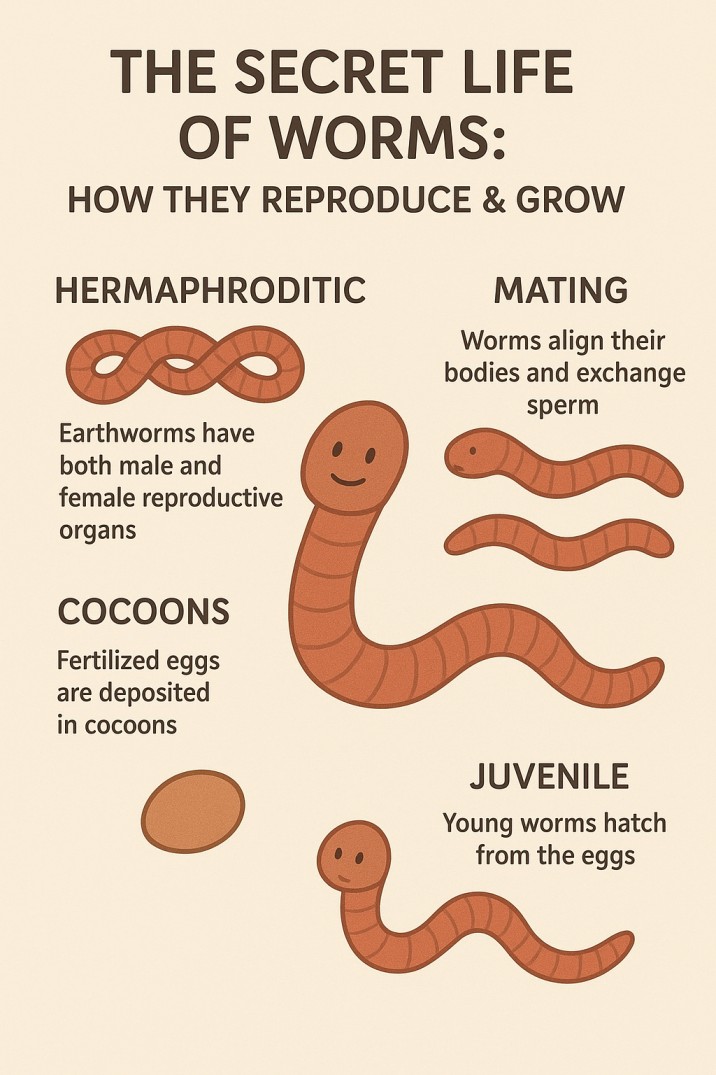If you’ve ever wondered how worms multiply and contribute to healthy soil, you’re in the right place. At Meme’s Worms, we specialize in composting worms, fishing worms, and earthworms for gardens, helping enthusiasts and gardeners understand these fascinating creatures. In this article, we’ll explore how worms reproduce, their life cycles, and tips for maintaining a healthy worm population in your worm farm.
Common Worms Used in Composting and Gardening
When it comes to vermiculture and vermicomposting, several worm species are commonly used. Red wigglers (Eisenia fetida) are perfect for composting and small worm farms, while European nightcrawlers (Eisenia hortensis) are ideal for gardens and larger compost systems. Earthworms (Lumbricus terrestris) are excellent for aerating soil but reproduce more slowly.
At Meme’s Worms, we offer red wigglers for sale, European nightcrawlers for sale, and other live worms suitable for composting or fishing. By selecting the right worms for your purpose, you can create a productive and healthy worm ecosystem.
Are Worms Hermaphrodites?
Yes! Worms are hermaphrodites, meaning each worm possesses both male and female reproductive organs. However, they cannot self-fertilize—they require a partner to reproduce. This means that in your worm farm, pairing worms is essential for population growth.
How Worms Reproduce?
Worm reproduction involves several key steps:
1. Mating
Two worms align their bodies ventrally and exchange sperm. This usually happens at night and can last several hours. After mating, each worm stores the sperm until it is ready to fertilize its eggs.
2. Cocoon Formation
Once fertilized, worms secrete a small, lemon-shaped cocoon from their clitellum, a thickened section near the head. Each cocoon may contain 1 to 20 eggs, depending on the species. Red wigglers, for instance, typically have fewer eggs per cocoon, while European nightcrawlers can have more.
3. Egg Development
Inside the cocoon, the eggs develop over 2–3 weeks. The speed of development depends on temperature and moisture. At Meme’s Worms, we recommend keeping your worm beds damp and at a temperature range of 55–77°F to encourage faster reproduction.
4. Hatching
Baby worms, or wormlings, emerge fully formed from the cocoon. Though tiny, they immediately begin feeding on organic matter in the compost bin or garden soil. With proper care, they mature into adults ready to reproduce in 6–8 weeks.
The Life Cycle of Worms
Understanding the worm life cycle helps maintain a thriving worm farm.
- Egg Stage (Cocoon): Worm eggs are encased in a protective cocoon and develop over 2–3 weeks.
- Juvenile Stage: Once hatched, wormlings are tiny and lack a clitellum. During this stage, they grow rapidly while feeding on compost or organic matter.
- Adult Stage: Worms develop a clitellum and become capable of reproduction. Depending on the species, this occurs around 6–8 weeks after hatching.
Red wigglers mature faster than European nightcrawlers, so choosing the right species is important for the purpose of your worm farm—whether for composting, fishing, or garden enrichment.
Factors Affecting Worm Reproduction
Several factors can influence how quickly worms reproduce and how healthy they remain:
- Temperature: Worms thrive between 55–77°F. Extremes in temperature can slow reproduction or even kill them.
- Moisture: Worms need a damp environment, similar to a wrung-out sponge. Too much water can drown them, while too little can dry them out.
- Food: Worms consume organic matter such as fruit and vegetable scraps, shredded paper, coconut coir, and other compostable materials. Nutrient-rich bedding helps worms grow and reproduce faster.
- Density: Overcrowding can stress worms, slowing reproduction and growth. Maintain a balanced population in your worm farm.
Tips for Keeping Worms Alive
Whether you are raising worms for composting, gardening, or fishing, proper care is essential:
- Provide Proper Bedding: Use coconut coir, shredded cardboard, or leaf litter to keep the bedding moist and aerated.
- Maintain Optimal Temperature: Keep worms in a cool, shaded area to prevent overheating.
- Feed Regularly: Offer small amounts of organic scraps consistently instead of large piles at once.
- Avoid Harmful Substances: Do not feed worms meat, dairy, or oily foods, as they can harm your worms.
- Monitor pH Levels: Worms prefer slightly acidic to neutral conditions. Avoid overly acidic foods like citrus.
By following these tips, you can ensure that your worms reproduce efficiently and your worm farm thrives year-round.
Why Understanding Worm Reproduction Matters
Knowing how worms reproduce and their life cycles allows gardeners, composters, and fishing enthusiasts to:
- Maintain a steady worm population in their worm farms.
- Improve compost production with healthy, active worms.
- Select the right species for gardening, composting, or fishing.
- Increase the efficiency of vermiculture systems for personal or commercial use.
At Meme’s Worms, we are passionate about educating our customers on vermiculture and providing healthy worms for any purpose. Whether you need worms for compost, live worms for fishing, or worms for gardens, understanding their reproduction and life cycles ensures the best results.
Contact Meme’s Worms
For live worms for sale, bulk worms, or advice on maintaining your worm farm, reach out to us today:
Phone: 229-507-0203
Email: hello@memesworms.com
We offer a variety of worms including red wigglers for composting, European nightcrawlers for sale, and other earthworms suitable for gardens or fishing. Start your worm farm today and see how these incredible creatures can transform your compost and soil health.



















